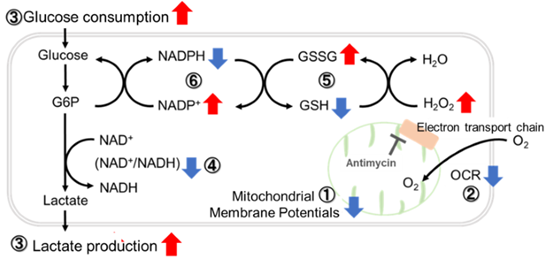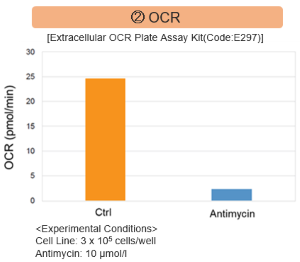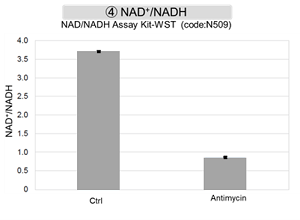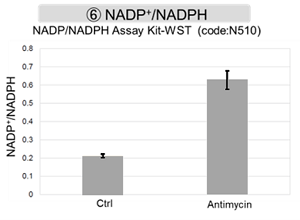特点:
● 适用于普通荧光酶标仪
● 不需要昂贵的仪器、特殊介质和孔板
● 带OCR计算表的一体式试剂盒


产品解说
产品规格

OCR计算器
OCR是线粒体功能的重要指标
由于氧主要在线粒体氧化磷酸化产生三磷酸腺苷(ATP)的过程中消耗,因此其耗氧率(OCR)是分析线粒体功能的指标。众所周知,癌细胞通过糖酵解途径产生ATP,其效率低于氧化磷酸化。在免疫细胞中,氧化磷酸化的优势是抑制抗肿瘤,而糖酵解途径的优势促进抗肿瘤作用。因此,细胞的OCR作为能量代谢的检测指标。


产品概述
细胞外氧消耗量试剂盒包括氧气探针,其具有随着介质中氧气浓度的降低而增加荧光强度的特性,矿物油阻止氧气从空气中流入。
在用荧光酶标仪根据细胞外氧浓度测量荧光强度之后,根据Stern-Volmer方程计算细胞的OCR(自动计算表)。


*该产品在群马大学Toshitada Yoshihara博士的指导下实现了产品化。
与现有方法比较
到目前为止,OCR测量需要昂贵的设备,如通量分析仪,实时动态检测酶标仪,以及酶标仪的功能调节。该试剂盒推荐给初此使用的人,因为它可以与常规荧光酶标仪一起使用,并附带所有必要试剂的完整包装。

与石英分析仪对比
石英分析仪(XFe24)和本试剂盒在相同条件下(细胞类型、细胞数量和FCCP浓度)进行测量。
得到XFe24与本试剂盒相关氧消耗速度变化的数据。

细胞种类: HepG2
细胞数: 5×10⁴ cells/well
试剂: FCCP (Carbonyl cyanide 4-(trifluoromethoxy)phenylhydrazone)
FCCP 浓度: 2 μmol/l
实验例:抑制线粒体电子传输链
用抗霉素刺激大鼠细胞,评估线粒体电子运输链抑制后细胞状态的变化,检测多种指标。
结果表明,电子传输链的抑制导致(1)线粒体膜电位的降低和(2)OCR的降低。此外,观察到(3)整个糖酵解途径的NAD+/NADH比率降低,这是由于丙酮酸到乳酸的代谢增加,以维持糖酵解通路;(4)由于活性氧(ROS)增加,GSH耗竭;(6)由于谷胱甘肽生物合成所需NADPH减少,NADP+/NADPH比率增加。








实验例:细胞最大呼吸能力评估
在HepG2细胞中,通过FCCP刺激后OCR值的变化来评估细胞的最大呼吸。
在FCCP浓度分别2µmol/l和4µmol/l 测量OCR。与2µmol/l相比,在4µmol/l时观察到OCR降低,表明在2µmol/l FCCP时最大呼吸。


细胞: HepG2
细胞数: 5×104 cells/well
试剂: FCCP
FCCP 浓度 2, 4 μmol/l
实验例:不同细胞系代谢途径依赖性的比较
许多癌症细胞通过糖酵解途径产生ATP。另一方面,最近有报道称,糖酵解途径被抑制的癌症细胞,可通过增强线粒体功能将能量代谢转移到OXPHOS而达到存活的目的,代谢途径的依赖性因细胞系不同而异。
基于乳酸生成、ATP水平和OCR值,比较了两种癌症细胞HeLa和HepG2中OXPHOS和糖酵解的依赖性关系。
<通过乳酸生产和ATP水平进行评估>
我们证实了当寡霉素刺激和糖酵解途径中的 2-Deoxy-D-glucose(2-DG)抑制OXPHOS的ATP合成时,ATP和乳酸产生的变化。结果表明,HeLa细胞依赖于糖酵解,HepG2细胞依赖于OXPHOS合成ATP。
*有关结果的更多信息,请参下方的“所用技术和产品的补充信息”部分。
| 所用技术和产品的补充信息 |
| <通过乳酸产生和ATP的量进行评估>
当OXPHOS在HeLa细胞中被抑制时,ATP水平保持不变(①),乳酸产生增加(②)。这表明,即使OXPHOS被抑制,糖酵解也可以被进一步激活。相反,当糖酵解被抑制时,ATP水平显著降低(③),表明能量的产生依赖于糖酵解。另一方面,当OXPHOS在HepG2细胞中被抑制时,乳酸的产生增加(④),表明细胞试图通过增强糖酵解来补偿能量的产生,但ATP水平仍然降低(⑤)。这意味着,即使糖酵解增加,ATP的产生也没有得到足够的代偿。此外,当糖酵解被抑制时,ATP水平下降更多(⑥),这表明HepG2细胞的能量产生更多地依赖于OXPHOS而不是糖酵解。 |

本数据同时使用了:糖酵解/氧化磷酸化检测试剂盒—Glycolysis/OXPHOS Assay Kit(G270)
<OCR值评估>
使用相同数量的细胞,我们测量了当用线粒体解偶联剂FCCP刺激细胞来促进细胞耗氧量时的OCR值。结果表明,HepG2细胞比HeLa细胞具有更高的OCR值,这表明对OXPHOS的依赖性更强,这与ATP水平和乳酸产生的结果有关。

〈实验条件〉
细胞系:HeLa、HepG2
细胞数:5×104个细胞/孔
刺激:FCCP
浓度:2μmol/l
使用:Oxygen Consumption Rate(OCR) Plate Assay Kit-氧消耗量检测试剂盒(货号:E297)进行评估
Q&A
| Q:本试剂盒可以检测多少样本? |
| A:当测试一种细胞类型的相同数量的细胞时,可以测量24个样品。
*如果实验中使用了两种以上的细胞类型或多个细胞编号,则必须准备单独的空白和对照,并且可以测量的样本数量会有所不同。 有关详细信息,请参考手册中的板布局示例。 |
| Q:悬浮细胞有什么实验案例吗? |
| A:我们准备了一个大鼠细胞实验的例子。<说明>
(1) 将大鼠细胞(3.0×106细胞/ml)悬浮于RPMI培养基中作为空白3,将大鼠细胞(3.0×106细胞/ml)悬于工作溶液中作为对照或样品。将细胞接种在100µl(300000个细胞/孔)的96孔黑色透明底部微孔板中。
(2) 向空白1中加入100µl RPMI培养基,向空白2中加入100μl工作溶液。
(3) 将微孔板放置在预先设定为37°C的读板器中,孵育30分钟。
(4) 向空白1、空白2、空白3和对照品中加入10µl RPMI培养基。
(5) 将用RPMI培养基稀释的样品溶液(抗霉素或FCCP溶液)分10µl加入样品中。
(6) 加入样品溶液后,立即向每个孔中加入一滴矿物油。
(7) 将微板放置在37°C的平板读数器中,孵育5分钟。
(8) 在一个时间过程中,用荧光板读取器每10分钟测量一次强度,持续200分钟(Ex:500nm,Em:650nm,底部读数)。 (9) OCR值通过将获得的强度值输入下载的专用Excel计算表来计算。 每孔所需的样品和试剂数量。
|
| Q:如何使用此试剂盒计算OCR? |
| A:请使用Excel计算表并遵循以下说明
<OCR计算程序概述> (1) 将OCR测量获得的强度值输入计算表,使用Stern-Volmer公式自动计算氧含量(nmol)。 (2) 根据时间(min)与氧含量(nmol)的关系图,检查所有测量条件下获得的线性范围。 (3) 计算步骤(2)中确认的时间(min)和氧含量(nmol)范围内的斜率。 (4) 根据步骤(3)中计算的斜率计算OCR(pmol/min)。 有关详细信息,请参阅手册中的“分析”。 *需要计算OCR的客户请至【网站首页】-【技术支持】-【实验工具】即可找到OCR计算器 |
| Q:矿物油对细胞有细胞毒性吗? |
| A: 当通过Cell Counting Kit-8细胞毒性测定测定时,在用矿物油处理的细胞中未观察到毒性。 |
| Q:为什么使用此试剂盒需要搭配可控温的酶标仪? |
| A: 在添加试剂和矿物油后,将微孔板与培养箱(或加热块、恒温室等)一起孵育,酶标仪中的温差将影响OCR结果。这导致数据再现性下降。因此,请使用温度可控的酶标仪。
<常规操作>
步骤3、7用于悬浮细胞,步骤5、9用于贴壁细胞 <孵育环境对结果的影响>
|
| Q:OCR检测后如何测量细胞数? |
| A:使用核酸探针(代码:H342)Hoechst 33342测量每个孔的细胞数,这是该方案的一个示例。
<说明> (1) 将细胞接种到孔中进行OCR测量(液体体积:100μl/孔)。 (2) 将制备校准曲线的细胞接种到孔中(液体体积:100μl/孔)。 (3) OCR根据说明书进行测量。 (4) 向孔中加入10µl/孔的介质进行校准(使介质体积与OCR测量孔的体积对齐至110µl/孔)。 (5) 将用培养基稀释的Hoechst 33342溶液(10µg/ml)以100µl/孔的速度添加到所有孔中。 *从油的顶部添加OCR测量孔。 (6) 在37°C下培养30分钟。 (7) 用荧光板读数器(Ex:350nm,Em:461nm)测量。 (8) 制备校准曲线(X轴:细胞数量,Y轴:荧光强度),并计算用于OCR测量的孔中的细胞数量。
|
| Q:可以长期存储工作液吗 |
| A 工作液不能储存,需要现配现用。 |
| Q:氧探针或矿物油的反复冷冻和解冻是否会影响测定? |
| A 我们已经证实,氧气探针和矿物油的反复冻融循环对测定没有影响。 |
| Q:对照组与实验组之间OCR没有差异,有哪些可能得原因? |
| A请检查以下两个实验条件。
(1) 如果在测量过程中温度发生变化,可能会影响OCR结果。请确保以下两个步骤完全按照说明书执行。 ・矿物油、溶剂和稀释溶剂等溶液在使用前应预热至37°C左右。 ・加入试剂和矿物油后,请使用温度可控的酶标仪进行孵育。 请参阅Q&A“为什么使用此试剂盒需要搭配可控温的酶标仪?”。 (2) 建议在最终计算前,优化单元格数据。如果细胞数量较低,实验组和对照组之间的差异也可能并不显著。 【带有细胞数和试剂处理的OCR值(预期结果图)】
|
参考文献
| 文献 | 研究对象 | 引用文献 |
| 1 | 细胞(HepG2) | K.Saito.et al“Obesity-induced metabolic imbalance allosterically modulates CtBP2 to inhibit PPAR-alpha transcriptional activity”2023,Journal of Biological Chemistry,doi.org/10.1016/j.jbc.2023.104890 |
| 2 | 细胞(NIH3T3-L1) | S. Oki, S. Kageyama, Y. Morioka and T. Namba, “Malonate induces the browning of white adipose tissue in high-fat diet induced obesity model”, Biochem Biophys Res Commun., 2023, doi:10.1016/j.bbrc.2023.08.054. |
| 3 | 细胞
(Primary Hepatocyte) |
S. Tsuno, K. Harada, M. Horikoshi, M. Mita, T. Kitaguchi, M. Y. Hirai, M. Matsumoto and T. Tsubo , ‘Mitochondrial ATP concentration decreases immediately after glucose administration to glucose-deprived hepatocytes’, FEBS Open Bio, 2023, doi:10.1002/2211-5463.13744. |
| 4 | 精子 | “Arresting calcium-regulated sperm metabolic dynamics enables prolonged fertility in poultry liquid semen storage”, Scientific Reports , 2023 , doi: 10.1038/s41598-023-48550-2. |
| 5 | 细胞(HepG2) | Takeo Nakanishi.et al“An implication of the mitochondrial carrier SLC25A3 as an oxidative stress modulator in NAFLD“Experimental Cell Research.,2023,431,113740 |













 Magnetic Base Drawing
Magnetic Base Drawing 














 HR2-320 Seed Bead User Guide
HR2-320 Seed Bead User Guide HR4-780 Seed Bead Steel User Guide
HR4-780 Seed Bead Steel User Guide HR4-781 Seed Bead Ceramic User Guide
HR4-781 Seed Bead Ceramic User Guide HR4-782 Seed Bead Glass User Guide
HR4-782 Seed Bead Glass User Guide 











 HR3-151 LCP Sandwich Set User Guide
HR3-151 LCP Sandwich Set User Guide HR3-151 LCP Sandwich Set Dimension Drawing
HR3-151 LCP Sandwich Set Dimension Drawing